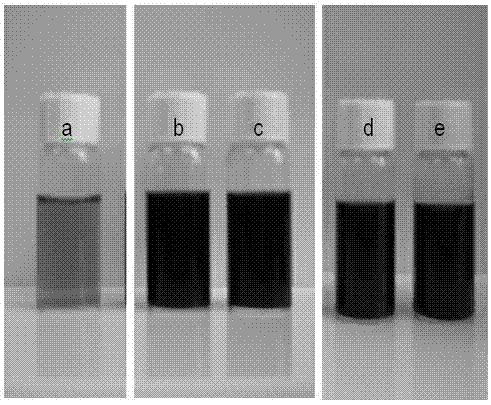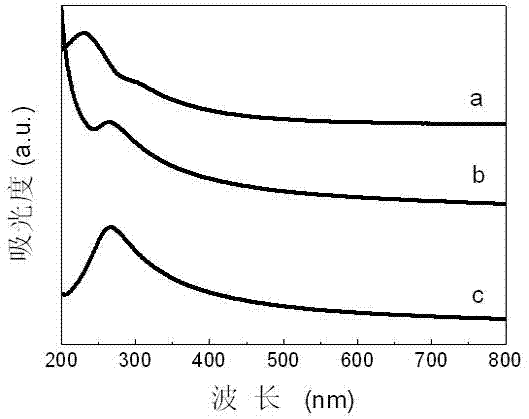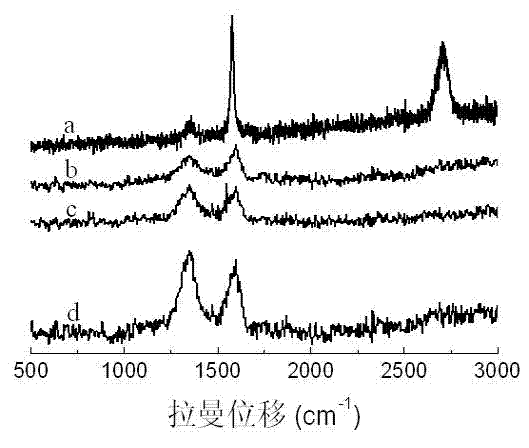Reduction method for graphene oxide
A technology of graphene and stone oxide, which is applied in the field of preparing stable graphene aqueous solution, can solve problems such as environmental pollution, and achieve the effect of simple and easy preparation method, low cost, and easy popularization and use
- Summary
- Abstract
- Description
- Claims
- Application Information
AI Technical Summary
Problems solved by technology
Method used
Image
Examples
Embodiment 1
[0021] 1) Natural graphite is oxidized by Hummers' method (1. Kovtyukhova, NI; Ollivier, PJ; Martin, BR; Mallouk, TE; Chizhik, SA; Buzaneva, EV; Gorchinskiy, AD Layer-by-layer assembly of ultrathin composite films from micron-sized graphite oxide sheets and polycations. Chem. Mater. 1999, 11, 771–778. 2. Hummers, W. S.; Offeman, R. E. Preparation of graphite oxide. J. Am. Chem. Soc. 1958, 80, 1339.), the obtained graphite oxide was prepared by ultrasonic dispersion method to prepare graphene oxide aqueous solution, and the obtained solution was yellow or yellow-brown. The unstripped graphite oxide was removed by centrifugation. The concentration of graphene oxide was 0.05 wt%.
[0022] 2) Take 50ml of 0.05 wt% graphene oxide solution, adjust the pH to about 10 with ammonia, then add 125 μL of 14 wt% acetoxime aqueous solution, and reflux at 100 ℃ for 3h to obtain black graphene aqueous solution.
Embodiment 2
[0024] Similar to the synthesis method in Example 1, the difference is that the same amount of hydrazine hydrate is used instead of acetoxime, and the graphene aqueous solution is prepared by reduction.
[0025] Such as figure 1 As shown, (a) is a brown-yellow graphene oxide solution. (b) and (c) are graphene solutions obtained by chemical reduction of graphene oxide using acetoxime and hydrazine hydrate as reducing agents, and the color of the graphene solution has changed from the original brownish yellow to the current black. (d) and (e) are graphene solutions that have been left for 2 months. They still exhibit good dispersibility without significant sedimentation.
[0026] Such as figure 2 As shown, (a) is the UV-vis spectrum of graphene oxide, which shows π→π of C-C bond at 231 nm * The absorption peak. (b) and (c) are the UV-vis spectra of graphene solutions obtained by reduction using acetoxime (b) and hydrazine hydrate (c), respectively. It can be seen that when the gra...
Embodiment 3
[0035] Similar to Example 1, the difference is that the graphene oxide was purchased from Nanjing Xianfeng Nano Material Technology Co., Ltd., and a black graphene aqueous solution was prepared according to the same reduction method. The characterization results were similar to the synthesized product in Example 1.
PUM
| Property | Measurement | Unit |
|---|---|---|
| particle size (mesh) | aaaaa | aaaaa |
Abstract
Description
Claims
Application Information
 Login to View More
Login to View More - R&D
- Intellectual Property
- Life Sciences
- Materials
- Tech Scout
- Unparalleled Data Quality
- Higher Quality Content
- 60% Fewer Hallucinations
Browse by: Latest US Patents, China's latest patents, Technical Efficacy Thesaurus, Application Domain, Technology Topic, Popular Technical Reports.
© 2025 PatSnap. All rights reserved.Legal|Privacy policy|Modern Slavery Act Transparency Statement|Sitemap|About US| Contact US: help@patsnap.com



